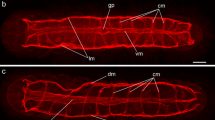Summary
The morphology of the compound eye of the noctuid moth Spodoptera exempta was investigated by electron microscopy. This eucone superposition eye is composed of about 8000 ommatidia. Each ommatidium is surrounded by six secondary pigment cells showing pigment movement according to the state of adaptation. It contains four crystalline cone cells forming together a crystalline cone and tract, two primary pigment cells, which encompass the crystalline cone, and usually eight retinula cells. On the basis of their rhabdomeric structure, three types of retinula cells can be distinguished. According to the structure of the rhabdom, two types of ommatidia are found in different regions of the eye. The rhabdom of the lobed type, providing more than 80% of ommatidia, is composed of V-shaped rhabdomeres with fanwise arranged microvilli. The rhabdom of the square type, found in a small area in the dorsal region of the eye, consists of triangular rhabdomeres with parallel microvilli. The functional significance of this difference is discussed.
Similar content being viewed by others
References
Agee HR (1971) Histology of the compound eye of Heliothis zea. Ann Ent Soc Am 64:85–88
Agee HR (1975) Adult beet armyworm and fall armyworm: histology of the compound eye. Florid Entom 58:165–166
Birukow G (1953) Menotaxis in polarisiertem Licht bei Geotrupes silvaticus. Naturwissenschaften 40:611–612
Bohn H, Täuber U (1971) Beziehungen zwischen der Wirkung polarisierten Lichtes auf das Elektroretinogramm und der Ultrastruktur des Auges von Gerris lacustris L. Z vergl Physiol 72:32–53
Burkhardt D, Wendler L (1960) Ein direkter Beweis für die Fähigkeit einzelner Sehzellen des Insektenauges, die Schwingungsrichtung polarisierten Lichtes zu analysieren. Z vergl Physiol 43:687–692
Duelli P, Wehner R (1973) The spectral sensitivity of polarized light orientation in Cataglyphis bicolor (Formicidae, Hymenoptera). J Comp Physiol 86:37–53
Eguchi E, Waterman TH (1968) Cellular basis for polarized light perception in the spider crab Libinia. Z Zellforsch 84:87–101
Fernández-Morán H (1958) Fine structure of the light receptors in the compound eyes of insects. Exp Cell Res, Suppl 5:586–644
Fischer A, Horstmann G (1970) Der Feinbau des Auges der Mehlmotte Ephestia kuehniella Zeller (Lepidoptera, Pyralididae). Z Zellforsch 116:275–304
Frisch K v (1949) Die Polarisation des Himmelslichtes als orientierender Faktor bei den Tänzen der Biene. Experientia 5:142–148
Goldsmith TH (1975) The polarization sensitivity-dichroic absorption paradox in arthropod photoreceptors. In: Snyder AW, Menzel R (eds) Photoreceptor optics. Springer, Berlin Heidelberg New York
Herrling PL (1976) Regional distribution of three ultrastructural retinula types in the retina of Cataglyphis bicolor Fabr. (Formicidae, Hymenoptera). Cell Tissue Res 169:247–266
Horridge GA (1969) The eye of the firefly Photuris. Proc Roy Soc B 171:445–463
Horridge GA (1976) The ommatidium of the dorsal eye of Cleon as a specialization for photoreisomerization. Proc R Soc Lond B 193:17–29
Kuwabara M, Naka K (1959) Response of a single retinula cell to polarized light. Nature (London) 184:455–456
Langer H, Hamann B, Meinecke CC (1975) Tetrachromatic visual system in the moth Spodoptera exempta (Insecta, Noctuidae). J Comp Physiol 129:235–239
Laughlin SB, McGuinness S (1978) The structures of dorsal and ventral regions of a dragonfly retina. Cell Tissue Res 188:427–447
Laughlin SB, Menzel R, Snyder AW (1975) Membranes, dichroism and receptor sensitivity. In: Snyder AW, Menzel R (eds) Photoreceptor optics. Springer, Berlin Heidelberg New York
Meyer-Rochow VB (1974) Structure and function of the larval eye of the sawfly Perga. J Insect Physiol 20:1565–1591
Moody MF, Parriss JR (1961) The discrimination of polarized light by Octopus: a behavioural and morphological study. Z vergl Physiol 44:268–291
Perrelet A (1970) The fine structure of the retina of the honey-bee drone. An electron microscopical study. Z Zellforsch 108:530–562
Ribi WA (1978) A unique hymenopteran compound eye. The retina fine structure of the digger wasp Sphex cognatus Smith (Hymenoptera, Sphecidae). Zool Jb Anat Bd 100:299–342
Ribi WA (1979) Do rhabdomeric structures in bees and flies really twist? J Comp Physiol 134:108–112
Rose DJW (1979) The significance of low-density populations of the African armyworm Spodoptera exempta Walk. Phil Trans R Soc Lond B 287:393–402
Schinz HR (1975) Structural specialisation in the dorsal retina of the bee, Apis mellifera. Cell Tissue Res 162:23–34
Schneider L, Gogala M, Draslar K, Langer H, Schlecht P (1978) Feinstruktur und Schirmpigmenteigenschaften der Ommatidien des Doppelauges von Ascalaphus (Insecta, Neuroptera). Cytobiologie 16:274–307
Schneider L, Langer H (1969) Die Struktur des Rhabdoms im „Doppelauge” des Wasserläufers Gerris lacustris. Z Zellforsch 99:538–559
Shaw SR (1969) Sense-cell structure and interspecies comparisons of polarized-light absorption in arthropod compound eyes. Vision Res 8:1031–1040
Spurr AR (1969) A low-viscosity epoxy resin embedding medium for electron microscopy. J Ultrastruc Res 26:31–43
Stockhammer K (1956) Zur Wahrnehmung der Schwingungsrichtung linear polarisierten Lichtes bei Insekten. Z vergl Physiol 38:30–83
Tuurala O (1954) Histologische und physiologische Untersuchungen über die photomechanischen Erscheinungen in den Augen der Lepidopteren. Ann Acad Sci Fenn A 24:2–69
Venable JH, Coggeshall R (1956) A simplified lead citrate stain for use in electron microscopy. J Cell Biol 25:407–408
Waterman TH (1975) The optics of polarization sensitivity. In: Snyder AW, Menzel R (eds) Photoreceptor optics. Springer, Berlin Heidelberg New York
Waterman TH, Fernández HR (1970) E-vector and wavelength discrimination by retinular cells of the crayfish Procambarus. Z vergl Physiol 68:154–174
Welsch B (1977) Ultrastruktur und funktionelle Morphologie der Augen des Nachtfalters Deilephila elpenor (Lepidoptera, Sphingidae). Cytobiologie 14:378–400
Yagi N, Koyama N (1963) The compound eye of Lepidoptera. Shinkyo-Press, Tokio
Young RW (1976) Visual cells and the concept of renewal. Invest Ophthal 15:700–725
Author information
Authors and Affiliations
Additional information
The author wishes to thank Prof. H. Langer and S. Razmjoo for reading and discussing the manuscript and Mrs. A. Geratsch for technical assistance
Rights and permissions
About this article
Cite this article
Meinecke, C.C. The fine structure of the compound eye of the African armyworm moth, Spodoptera exempta walk. (Lepidoptera, Noctuidae). Cell Tissue Res. 216, 333–347 (1981). https://doi.org/10.1007/BF00233623
Accepted:
Issue Date:
DOI: https://doi.org/10.1007/BF00233623




